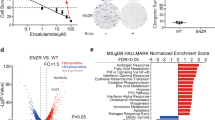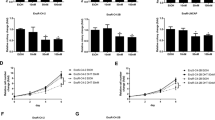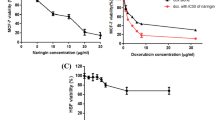Abstract
Most tumor cells are sensitive to tumor necrosis factor-related apoptosis-inducing ligand (TRAIL)-induced apoptosis but sparing to normal cells, thus providing therapeutic potential for clinical use. Some tumor cells are resistant to TRAIL-induced cell death while the sensitivity could be recruited with the existence of some chemical agents. In this study, human prostatic cancer cell line LNCaP was found to be resistant to TRAIL-induced apoptosis while it could be restored to TRAIL sensitivity with combination treatment of low concentration of doxorubicin. TRAIL receptor-1 (DR4) and TRAIL receptor-2 (DR5) were upregulated under the treatment of doxorubicin and verified to be responsible for TRAIL-mediated signal transduction. Furthermore, caspase-8 and caspase-3 were activated and drove their autocleavage into programmed cell death. Interestingly, apoptosis-inhibitory protein c-FLIP, but not Bcl-2 and XIAP was downregulated after doxorubicin treatment. Taken together, these findings suggested that the pathway of cell apoptosis induced by TRAIL was intact but under negative control. Subtoxic concentration of doxorubicin effectively boosted TRAIL sensitivity via depletion of antiapoptotic protein. These findings support the new strategies for killing tumors with TRAIL and chemical agents.
This is a preview of subscription content, access via your institution
Access options
Subscribe to this journal
Receive 4 print issues and online access
$259.00 per year
only $64.75 per issue
Buy this article
- Purchase on Springer Link
- Instant access to full article PDF
Prices may be subject to local taxes which are calculated during checkout






Similar content being viewed by others
References
Ashkenazi A, Dixit V . Death receptors: signaling and modulation. Science 1998; 281: 1305–1308.
Zhang XD et al. Relation of TNF-related apoptosis-inducing ligand (TRAIL) receptor and FLICE-inhibitory protein expression to TRAIL-induced apoptosis of melanoma. Cancer Res 1999; 59: 2747–2753.
Bodmer J et al. TRAIL receptor-2 signals apoptosis through FADD and caspase-8. Nat Cell Biol 2000; 2: 241–243.
Walczak H et al. Tumoricidal activity of tumor necrosis factor related apoptosis-inducing ligand in vivo. Nat Med 1999; 5: 157–163.
Salvesen G, Dixit VM . Caspase activation: the induced-proximity model. Proc Natl Acad Sci USA 1999; 96: 10964–10967.
Green D . Apoptotic pathways: the roads to ruin. Cell 1998; 94: 695–698.
Pan GH et al. An antagonist decoy receptor and a death domain-containing receptor for TRAIL. Science 1997; 277: 815–818.
Pan GH, Ni J, Wei YF, Dixitet VM . TRUNDD, a new member of the TRAIL receptor family that antagonizes TRAIL signaling. FEBS Lett 1998; 424: 41–45.
Srinivasula S et al. FLAME-1, a novel FADD-like anti-apoptotic molecule that regulates Fas/INFR1-induced apoptosis. J Biol Chem 1997; 272: 18542–18545.
Adams JM, Cory S . Life-or-death decisions by the BCL-2 protein family. Trends Biochem Sci 2001; 26: 61–66.
Tamm I et al. IAP-family protein surviving inhibits caspasse activity and apoptosis induced by Fas (CD95), Bax, caspases, and anticancer drugs. Cancer Res 1998; 58: 5315–5320.
Tang D, Lahti JM, Grenet J, Kidd VJ . Cycloheximide-induced T-cell death is mediated by a Fas-associated death domain-dependent mechanism. J Biol Chem 1999; 274: 7245–7252.
Jian K et al. Chemical sensitization and regulation of TRAIL-induced apoptosis in a panel of B-lymphocytic leukaemia cell lines. Br J Haematol 2003; 123: 921–932.
Jinghai W et al. Antileukemic drugs increase death receptor 5 levels and enhance Apo-2L-induced apoptosis of human acute leukemia cells. Blood 2000; 96: 3900–3906.
Leverkus M et al. Regulation of tumor necrosis factor-related apoptosis inducing ligand sensitivity in primary and transformed human keratinocytes. Cancer Res 2000; 60: 553–559.
Irmler M et al. Inhibition of death receptor signals by cellular FLIP. Nature 1997; 388: 190–195.
Mitsiades N et al. Intracellular regulation of tumor necrosis factor-related apoptosis inducing ligand-induced apoptosis in human multiple myeloma cells. Blood 2002; 99: 2162–2171.
David WC et al. c-FLIP is a dual function regulator for caspase-8 activation and CD95-mediated apoptosis. EMBO J 2002; 21: 3704–3714.
MacFarlane M et al. Mechanisms of resistant to TRAIL-induced apoptosis in primary B cell chronic lymphocytic leukemia. Oncogene 2002; 21: 6809–6818.
Zhang XD et al. Differential localization and regulation of death and decoy receptors for TNF-related apoptosis-inducing ligand (TRAIL) in human melanoma cells. J Immunol 2000; 164: 3961–3970.
Tepper CG, Seldin MF . Modulation of caspase-8 and FLICE-inhibitory protein expression as a potential mechanism of Epstein–Barr virus tumorigenesis in Burkitt's lymphoma. Blood 1999; 94: 1727–1737.
Keogh SA, Walczak H, Bouchier-Hayes L, Martin SJ . Failure of BCL-2 to block cytochrome c redistribution during TRAIL-induced apoptosis. FEBS Lett 2000; 471: 93–98.
Roy N, Deveraux QL, Takahashi R, Salvesen GS, Reed JC . The c-IAP-1 and c-IAP-2 proteins are direct inhibitors of specific caspases. EMBO J 1997; 16: 6914–6925.
Ng CP, Zisman A, Bonavida B . Synergy is achieved by complementation with Apo2L/TRAIL and actinomycin D in Apo2L/TRAIL-mediated apoptosis of prostate cancer cells: role of XIAP in resistance. Prostate 2002; 53: 286–299.
Deveraux QL, Takahashi R, Salvvesen GS, Reed JC . X-linked IAP is a direct inhibitor of cell-death proteases. Nature 1997; 338: 300–304.
Author information
Authors and Affiliations
Corresponding author
Rights and permissions
About this article
Cite this article
Kang, J., Bu, J., Hao, Y. et al. Subtoxic concentration of doxorubicin enhances TRAIL-induced apoptosis in human prostate cancer cell line LNCaP. Prostate Cancer Prostatic Dis 8, 274–279 (2005). https://doi.org/10.1038/sj.pcan.4500798
Received:
Revised:
Accepted:
Published:
Issue Date:
DOI: https://doi.org/10.1038/sj.pcan.4500798
Keywords
This article is cited by
-
Combined efficacy of Cinnamomum zeylanicum and doxorubicin against leukemia through regulation of TRAIL and NF-kappa B pathways in rat model
Molecular Biology Reports (2022)
-
Iscador Qu inhibits doxorubicin-induced senescence of MCF7 cells
Scientific Reports (2017)
-
Doxorubicin induces cardiotoxicity through upregulation of death receptors mediated apoptosis in cardiomyocytes
Scientific Reports (2017)
-
Guiding TRAIL to cancer cells through Kv10.1 potassium channel overcomes resistance to doxorubicin
European Biophysics Journal (2016)
-
Predicting environmental chemical factors associated with disease-related gene expression data
BMC Medical Genomics (2010)



